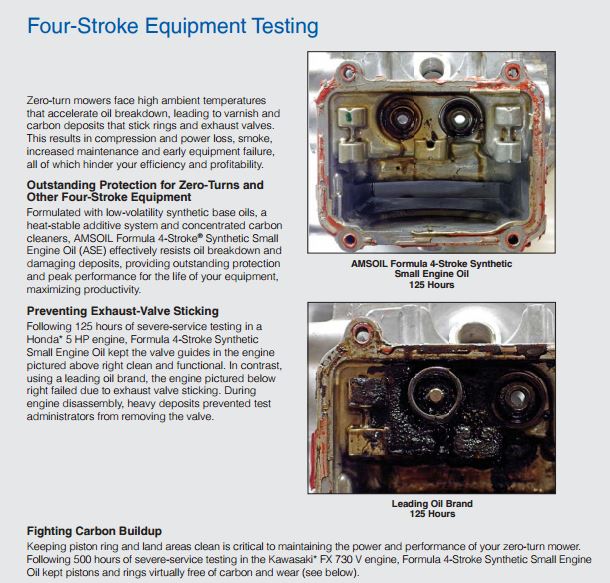Two-stroke equipment is changing
Ask your Sioux Falls small engine sales and repair shop to carry the standard which makes all 2-stroke work motors easy to maintain. SABER-PRO synthetic 2-cycle oil.
Hotter, leaner-running engines require less oil to do more work.
Dan Peterson | VICE PRESIDENT, TECHNICAL DEVELOPMENT
I spent my 53rd birthday in Tampa, Fla., during the 2016 DJ Convention, talking, listening, learning and making notes on how AMSOIL Dealer businesses have changed and what has driven those changes. This prompted a story I told the group about how AMSOIL is studying changes in handheld twostroke equipment. Allow me to share for those who weren’t in Tampa.
I grew up operating a range of two stroke equipment – mowers and string trimmers in the ‘70s and chainsaws in the ‘80s. I still have a 1980 25hp Mercury* outboard and an old two-stroke Lawn-Boy* mower, which has journeyed from Dayton, Ohio to Appleton, Wis. to Hermantown, Minn. It now resides at the cabin in Eagle River, Wis. The old Lawn-Boy runs great on SABER® Professional at 100:1. Occasionally, I use my equipment to burn the last of my neighbor’s summer gas. He uses Valvoline* mixed at 50:1. Boy, does it smoke in the old LawnBoy, but he’s a good neighbor and I like to help him out.
When I put the Valvoline mixed at 50:1 in my new Stihl* leaf blower, I don’t see as big a difference in exhaust smoke compared to SABER Professional at 100:1. There is some difference, but nothing compared to the Lawn-Boy.
Why? The answer lies in the design of the equipment. Before I was introduced to AMSOIL, I ran the Lawn-Boy at 50:1 and it always smoked, especially before it warmed up. It continued to spew blue smoke the whole time I mowed, just like it does on my neighbor’s end-of summer gas. When I start my new Stihl leaf blower and use the end-of-summer gas, it does not smoke nearly as much as the Lawn-Boy.
Older equipment was designed to run rich, which means it burned a lot of fuel/oil. Not all of it burned, so the partially burned fuel and oil exited the exhaust as smoke. In response to government mandates to reduce emissions, much of the handheld twostroke equipment built in the last four years is designed to run leaner. This means it burns less fuel/oil and more air. When engines run on less fuel/oil and more air, they generate less smoke and emissions, but they run much hotter.
The problems with older two-stroke equipment included fouled spark plugs, gummy deposits and smoke. SABER Professional mixed at 100:1 helped resolve those issues in older equipment. Now, however, the challenges to equipment operability and longevity have changed. Modern equipment runs on the ragged edge due to burning less oil. The intense heat leads to deposits, which can cause the following:
- Piston-ring sticking
- Blocked exhaust ports
- Plugged spark arrestor screens
As a result, equipment can lose power, become difficult to start and eventually quit running.
To be proactive with modern 2-cycle equipment, we went to work testing many different oil formulations in different types of equipment. In the end, we developed a formulation that delivers excellent protection against high heat and deposits. We tested and validated it at both 100:1 and 50:1. Although it’s safe and effective at both ratios, the benefits of reduced deposits and better cleanliness are more noticeable at 50:1 since more oil is available to lubricate the engine. For proof of SABER Professional’s performance at 50:1, see the ECHO String Trimmer Technical Study (G3455).
Here is where we all need to adapt to change. We all know our founder and Chairman of the Board Al Amatuzio designed the original SABER Professional to provide extraordinary benefits for the equipment of the time. In the same spirit, we’ve identified the most disruptive problems for lawn and landscapers when running today’s two-stroke equipment. And then we developed a formulation proven to address these issues.
What does this mean to your business?
If your customers are happy using SABER Professional at 80:1 or 100:1, great. They can continue to rely on its safe, effective performance. However, perhaps you encounter a prospect who rejects our 80:1 or 100:1 recommendation. Let’s face it – some prospects simply aren’t interested in the benefits of using less oil. Use the results of the ECHO String Trimmer Technical Study to sell them on SABER Professional’s exceptional performance at 50:1. You can also use the study to sell current customers on the benefits of running a 50:1 ratio in their equipment.
In the end, it’s up to you to know your customers and prospects and sell SABER Professional as the solution to the problems they’re facing. This study gives you the flexibility to do that.
Look for more SABER Professional comparisons soon.
Available in the Sioux Falls store at 4610 W. 12th st. Call 402-399-3902




